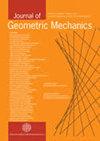Riemannian cubics and elastica in the manifold \begin{document}$ \operatorname{SPD}(n) $\end{document} of all \begin{document}$ n\times n $\end{document} symmetric positive-definite matrices
IF 1
4区 数学
Q3 MATHEMATICS, APPLIED
引用次数: 2
Abstract
Left Lie reduction is a technique used in the study of curves in bi-invariant Lie groups [ 32 , 33 , 40 ]. Although the manifold \begin{document}$ \operatorname{SPD}(n) $\end{document} of all \begin{document}$ n\times n $\end{document} symmetric positive-definite matrices is not a Lie group with respect to the standard matrix multiplication, it is a symmetric space with a left action of \begin{document}$ GL(n) $\end{document} and an isotropy group \begin{document}$ SO(n) $\end{document} leaving the identity matrix fixed. The main purpose of this paper is to extend the method of left Lie reduction to \begin{document}$ \operatorname{SPD}(n) $\end{document} and use it to study two second order variational curves: Riemannian cubics and elastica. Riemannian cubics in \begin{document}$ \operatorname{SPD}(n) $\end{document} are reduced to so-called Lie quadratics in the Lie algebra \begin{document}$ \mathfrak{gl}(n) $\end{document} and geometric analyses are presented. Besides, by using the Frenet-Serret frames and the extended left Lie reduction separately, we investigate elastica in the manifold \begin{document}$ \operatorname{SPD}(n) $\end{document} . The latter presents a comparatively simple form of the equations for elastica in \begin{document}$ \operatorname{SPD}(n) $\end{document} .Riemannian cubics and elastica in the manifold \begin{document}$ \operatorname{SPD}(n) $\end{document} of all \begin{document}$ n\times n $\end{document} symmetric positive-definite matrices
Left Lie reduction is a technique used in the study of curves in bi-invariant Lie groups [ 32 , 33 , 40 ]. Although the manifold \begin{document}$ \operatorname{SPD}(n) $\end{document} of all \begin{document}$ n\times n $\end{document} symmetric positive-definite matrices is not a Lie group with respect to the standard matrix multiplication, it is a symmetric space with a left action of \begin{document}$ GL(n) $\end{document} and an isotropy group \begin{document}$ SO(n) $\end{document} leaving the identity matrix fixed. The main purpose of this paper is to extend the method of left Lie reduction to \begin{document}$ \operatorname{SPD}(n) $\end{document} and use it to study two second order variational curves: Riemannian cubics and elastica. Riemannian cubics in \begin{document}$ \operatorname{SPD}(n) $\end{document} are reduced to so-called Lie quadratics in the Lie algebra \begin{document}$ \mathfrak{gl}(n) $\end{document} and geometric analyses are presented. Besides, by using the Frenet-Serret frames and the extended left Lie reduction separately, we investigate elastica in the manifold \begin{document}$ \operatorname{SPD}(n) $\end{document} . The latter presents a comparatively simple form of the equations for elastica in \begin{document}$ \operatorname{SPD}(n) $\end{document} .
本文章由计算机程序翻译,如有差异,请以英文原文为准。
求助全文
约1分钟内获得全文
求助全文
来源期刊

Journal of Geometric Mechanics
MATHEMATICS, APPLIED-PHYSICS, MATHEMATICAL
CiteScore
1.70
自引率
12.50%
发文量
23
审稿时长
>12 weeks
期刊介绍:
The Journal of Geometric Mechanics (JGM) aims to publish research articles devoted to geometric methods (in a broad sense) in mechanics and control theory, and intends to facilitate interaction between theory and applications. Advances in the following topics are welcomed by the journal:
1. Lagrangian and Hamiltonian mechanics
2. Symplectic and Poisson geometry and their applications to mechanics
3. Geometric and optimal control theory
4. Geometric and variational integration
5. Geometry of stochastic systems
6. Geometric methods in dynamical systems
7. Continuum mechanics
8. Classical field theory
9. Fluid mechanics
10. Infinite-dimensional dynamical systems
11. Quantum mechanics and quantum information theory
12. Applications in physics, technology, engineering and the biological sciences.
 求助内容:
求助内容: 应助结果提醒方式:
应助结果提醒方式:


